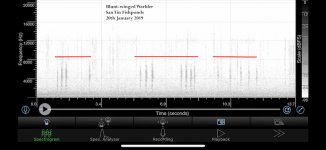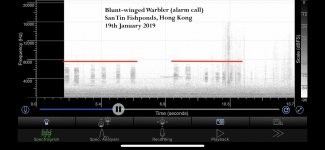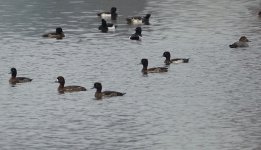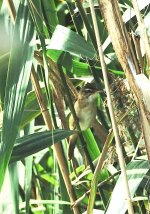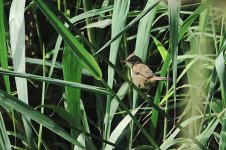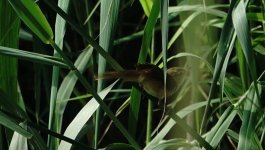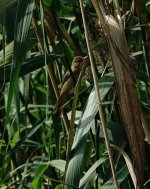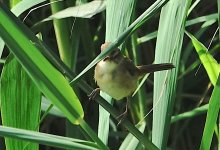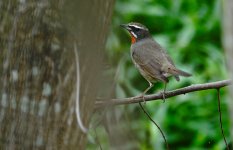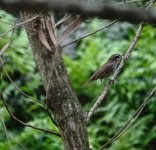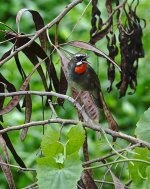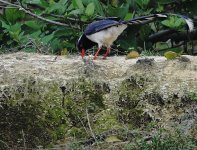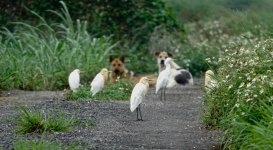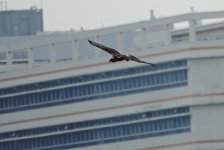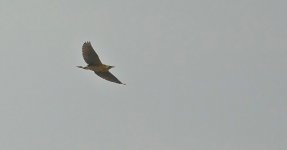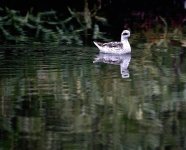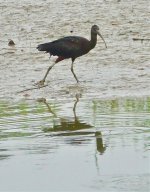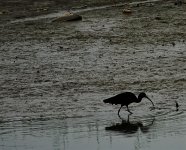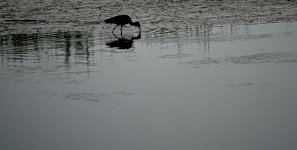Yesterday I took part in the 35th edition of WWF Hong Kong's Big Bird Race. My team, the Jebsen Eagles, comprising Richard (captain), Ruy, Karen and wonder driver Mo Yung. We drove an all-time short distance of 125 km, and walked over 25km covering five woodland and wetland sites across the Central and North-eastern New Territories.
The race was preceded by two weeks of feverish reconnaissance by my team members (I was mostly stuck in the office) complete with a WhatsApp account and spreadsheets for each recce conducted to document which species were at which sites, and critically to save time, which sites were not productive. By Thursday we had a plan, and come 0430 on Saturday morning I was up and on the way to meet the team exactly on time at the entrance to Shek Kong Catchment at 5:30, so that we would be in position for the pre-dawn start of the 12 hour race at 0600.
Shek Kong Catchment runs roughly east to west though decent secondary forest that climbs to about 400m, but also provides access to more one grassland and farmland habitats through a couple of paths down onto the floor of the Kam Tin valley. As we walked to the start point we heard a rather early Large Hawk Cuckoo, which didn't call again during the race, and one of our key pre-dawn targets - Collared Scops Owl. As usual we had a few nervy minutes as the race started and the owl stopped calling. As the light brightened the chance it would restart diminished. Our fist bird was instead the grumbling chatter of
Masked Laughingthrushes far down in the valley. Eventually the
Collared Scops Owl put us out of misery, as did a
Barred Owlet bubbling away on a spur away to our right. Most of us missed a Woodcock that Ruy saw as it zipped past, but we were soon adding species, including the sometimes tricky
Blue Whistling Thrush, Oriental Magpie Robin, a barking
Siberian Rubythroat, loads of very cheerful
Black-throated Laughingthrushes, including one doing a decent impression of Great Barbet which created some swiftly dashed excitement,
Silver-eared Mesias, and the first high pitched calls of
Ashy Drongo.
As it grew lighter we started to actually see birds, with
Grey Wagtail, Eastern Buzzard, a fine flock of around 50
Hair-crested Drongos in a wonderful flowering bombax,
Crested Mynas and Black-collared Starlings on some farmland in the valley below, three
White-rumped Munias - often tricky and sometimes missed during a bird race - that flew off from some tall grass - plus a
Green Sandpiper and
Chinese Pond Heron on a slurry pool, and
Barn Swallow, Spotted Dove and Chinese Bulbul nearby. Two
Large-billed Crows flew over and drew our attention to our bird of the day - a magnificent adult
Bonelli's Eagle soaring above the forest - which they harassed for a while before wandering off.
As we headed back along the catchment we added
Scarlet and Grey-chinned Minivets, Olive-backed Pipits, calling
Streak-breasted Scimitar Babbler, Rufous-capped Babbler, an Orange-bellied Leafbird, Cinereous Tit, Mountain Tailorbird, Asian Stubtail, Velvet-fronted Nuthatch, Scarlet-backed Flowerpecker and Yellow-browed Warblers, singing
Pallas's Warblers, a very showy pair of
Yellow-cheeked Tits and a
Speckled Piculet which Richard picked up on call and was then seen on a stump by Ruy and Karen, for whom it was a lifer. It was also my first since my finding one at Ng Tung Chai in September 2006. That bird was just the third Hong Kong record, but they have prospered in the interim, and are now found in many woodland sites across Hong Kong.
Having watched rain falling just a short distance away and seeing the sky not quite darkening above us we headed east to
Tai Po Kau for a second round of forest birding. The one steep climb of the day was fine in the cooler weather and even gave us a few birds - calling
Blue-winged Minlas, Striated Yuhinas, and a
Buff-bellied Flowerpecker, several
Chestnut Bulbuls, Pygmy Wren Babbler and a distant but distinctively singing
Lesser Shortwing.
Passing the dam and walking along the stream the darkness from the overhead clouds became almost stygian, but a as we pushed on a bird wave from the tree tops we picked up two good birds - a
Grey-haired Canary Flycatcher and a
Sulphur-breasted Warbler - one of a quartet of rare warblers which have been showing on and off in Tai Po Kau over the last few weeks.
Huet's Fulvetta and Fork-tailed Sunbirds also called, as did a couple of
Great Barbets from the ridge above before a short quiet patch was ended by the excellent but personally frustrating experience of hearing a
Chinese Barbet "trook-a-rook"-ing up on the same ridge as they Great Barbet had called from. This is a bird I've never seen in Hong Kong, but under our team bird race rules every species counts as one, and once its on the list we don't linger. Oh well ... another day.
On the way back past the stream another flock come through which held
Goodson's Leaf Warbler, a female
Verditer, and just before a
Rufous-tailed Robin sang softly from the undergrowth. Ruy and Karen both got onto a second Speckled Piculet found by the HKUST team.
And that was it for our forest birding. We were delighted to have picked up 63 species between 0600- 10:15, and then we zoomed off to Mai Po for the rising tide. Another benefit of the recces was that we knew the rising tide would be better, especially for the smaller waders, than the falling tide.
From the
Mai Po access road we added
Tufty, Dabchick, Great Cormorant, Black Kite, Great Egret, Collared Crow, Osprey, White-throated Kingfisher, Black Drongo, Silky Starling and
Common Myna, plus
Azure-winged Magpies feeding in some dead branches in the Mai Po carpark.
Pied Kingfisher, Pied Wagtail, Common Sandpiper, Garganey, Intermediate Egret, Black-crowned Night Heron and Shoveler were along the casuarinas, and the recently split
Oriental Magpie and a calling
Daurian Redstart kept he score ticking over as we headed across the centre of the reserve to the boardwalk.
In order to reduce overcrowding in the hide just two team members are allowed seats in the hide, but only two need to see each bird. Ruy and Karen stayed at the gate while Richard and I headed down to the new hide, adding a
Common Kingfisher that zipped away off the boardwalk and our first
Dusky Warblers.
We were just the second team in the new hide, and the exposed mud was carpeted with waders! We quickly picked up
Dunlin, Temminck's Stint, Pacific Golden, Grey Little Ringed, and Kentish Plovers plus the trickier
Greater and Lesser Sandplovers. There were a few
Great Knot and lots of both
Eurasian Curlews and Black-tailed Godwits as well as usual thousands of
Avocets and Black-headed Gulls. I enjoyed the
Saunders Gulls - several in handsome black hoods - searching for crabs on the mud - as waves of
Marsh Sandpipers, Common Redshanks and Common Greenshanks flew in and fed busily as the tide slowly rose.
There was no sign of the Caspian and Gull-billed Terns seen on the recces, but the gull flock did hold
Heuglin's, Caspian and Pallas's Gulls, the latter a solitary juvenile rather than the much sexier adults seen a couple of days earlier.
Out in the bay large flocks of
Wigeon, Pintail, and Shoveler were easily found, with a few
Eurasian Teals amongst them. Richard picked out a very distant
Eurasian Spoonbill in a group of five
Black-faced Spoonbills on the far side fo the mudflat and then a solitary
Great Crested Grebe that was even further away - close to the Tsim Bei Tsui Ferry Pier.
A quick scoot round to the easternmost hide enabled us to confirm
Bar-tailed Godwit and Red Knot as the tide rose and pushed the birds past the hide. We were disappointed not to connect with either the Long-billed Dowitcher or the Nordmann's Greenshank, which had been present earlier in the week , but did pick up another bonus on the way out as a
Manchurian Bush Warbler sand in the mangroves just outside the hide. We also had our only rain of the day as we headed back to the gate through the fence, but this had all but stopped by the time we had reconnected with Ruy and Karen and headed towards the southern end of the reserve.
Ruy and Karen had watched large numbers of birds flighting onto the Scrape and a few minutes scoping delivered both the
Long-billed Dowitcher and the helpfully pale
Nordmann's Greenshank amongst the assembled tringas. This claw back of two species we thought we'd missed set the pattern for the rest of the day. We had seven targets at the southern end of the reserve - Rook, Purple Heron, Eastern Marsh Harrier, Imperial and Greater Spotted Eagles, Peregrine and Chinese Spotbill. We connected with all of them except the eagles and the harrier - and importantly for our timeline and energy levels, we did so without having to walk all the way around!
We instead walked along the path to the south of the Scrape, which has views over the reedbeds in various places. These delivered first a male
Stejneger’s Stonechat and then the
Rook, which was flushed up into the trees at the southern tip by the All Stars team (thank you!), then a flyby male adult
Purple Heron, a couple of
Chinese Spotbills that were called out by the All Stars as they walked past us having done the full circuit, and finally a few minutes after the All Stars had moved on the
Peregrine showed hunting very low and disappeared out of sight before we could all get on it, but then climbed up and hung in the air enabling all four of us to nail it. Heading back to the car the
Eastern Marsh Harrier that has been masquerading as a Hen Harrier appeared over the seedbed in front of the Education Centre and two
Spotted Redshanks - a bird we had written off as it had only been seen away from our route during the week - appeared on the closest mudbank in Pond 11 - golden!
After a quick snack break we left Mai Po around 2:45 and headed for
San Tin. We had high hopes, but again the weather darkened threateningly as we bumped our way over to the ponds.
Collared Doves, Tree Sparrows, Richard's Pipits and Yellow Wagtails posed on the bunds,
Red-rumped Swallows were hawking over the ponds and a
Dusky Shrike lurked over the central drainage channel in a customary spot. Just a few yards further on my first
Sooty-headed Bubul at San Tin for a couple of years was perched above some banana trees. where one
Common Pochard and a couple of
Moorhen were showing on the pond with submerged vegetation, a
Zitting Cisticola sat up nicely,
Plain Prinia called and showed on the edge of the emergent grass and a solitary
Cattle Egret was sat on a wire overlooking its usual pond. We could not find the two Falcated Ducks and missed the Smew that the All Stars saw right next to the Pochard!
The northern edge produced the hoped-for
Red and Oriental Turtle Doves, plus several
White-cheeked Starlings as well as
Imperial and Great Spotted Eagles - the latter lurking on a perch inside the Lok Ma Chau reserve. A
Black-browed Reed Warbler responded nicely to pishing in the central ditch and a
Eurasian Kestrel behaved almost exactly like the Peregrine, flying rapidly away close to the ground before soaring up so that everyone could nail it!
Two
Red-throated Pipits (including the bird with the distinctive leucitic patch on the crown) appeared where they had not the previous Saturday and a
Black-faced Bunting gave brief flush views as we approach the rickety bridge. Here we made our bold decision to go for our staked-out
Eurasian Coot, and thankfully the fifteen minute diversion was rewarded as it emerged as if on cue from the reeds as we approached its pond. We also added
Black-winged Stilt here. The Taiga Flycatcher at the Blue Bridge on San Tin Main Drainage Channel declined to co-operate, but only cost us three or four minutes as we headed for our final destination - Long Valley - arriving around 4:30, and just 90 minutes remaining in the race.
Long Valley started with a bang. Having driven in to the Ho Sheung Heung entrance a
Chinese Francolin called from Crest Hill as we cross the bridge. Richard almost missed it as he had his head deep in a sandwich, but thankfully it called again adding a terrific bonus bird to our list. What it was doing calling on a dank February afternoon is anybody's guess!
A male Daurian Redstart was lurking in the bamboos by the first pond and Richard picked out another bonus bird - a
Pacific Swift that was foraging with the House Swifts above the lychee trees on the bunds near the village. Our four main targets were
Common Snipe, Swintail Snipe, Greater Painted-snipe and Bluethroat. The first three behaved beautifully, coming out of the wet agriculture and flying off into cover giving good views. The Bluethroat which had performed so well earlier in the week after Karen had found it decided it was not going to show for us, but irritatingly did show for the All Stars , even perching up on a wire, shortly after we had moved on!
With time running out we jumped onto the car at Yin Kong and zoomed down to Island House in Tai Po, where we failed to find the staked out Pacific Reef Egret, but did get lucky with a calling and then silhouetted
Blue Magpie with two minutes to go before the race ended.
We finished with 158 species, which was not only the winning score, but a victory by ten species over our nearest rivals!
Should you wish to sponsor our team - all funds raised go to WWF for habitat management at Mai Po - please click on the link below - Thank you!
https://apps2.wwf.org.hk/BBR2019/page/profile/288





